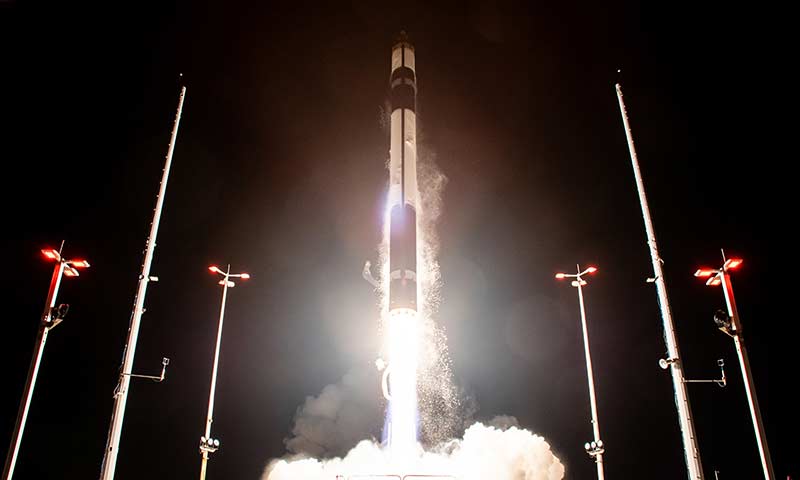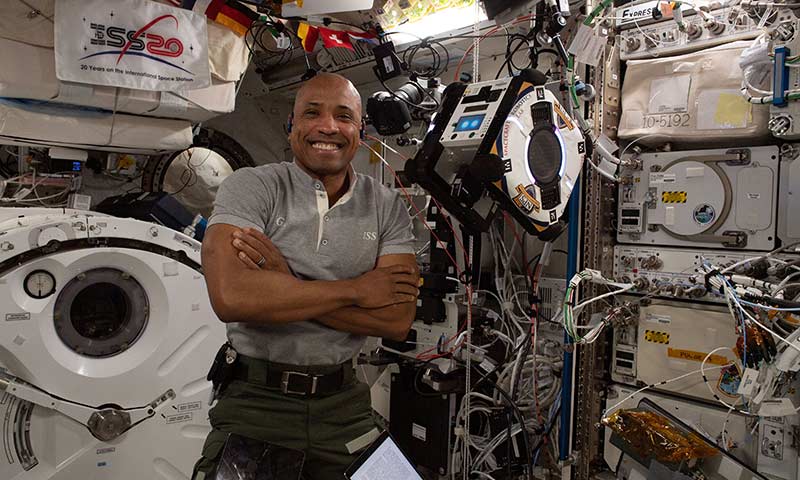Whether it’s providing accurate positioning and navigation, or enabling intelligence, surveillance, and reconnaissance, the space domain has never been more important to the U.S. Navy and Marine Corps.
Distributed maritime operations and the reality of strategic competition have led to increasing demand from the fleet for space-based capabilities including the satellite systems which serve as tactical communication and navigation lifelines to Navy ships at sea. Such strategic competition has also turned space into an increasingly contested environment – one which has significant defense implications.
As a result, the Navy and Marine Corps – the only all-domain warfighting force, from seabed to space, in the Department of Defense (DOD) – must remain innovative and agile to compete and prevail in the maritime domain. The Naval Postgraduate School (NPS) remains at the forefront in helping to meet the sea services needs in space, developing talent and technological solutions for decisive U.S. seapower and national defense.
A Trailblazing Tradition: NPS Astronauts Reach for the Stars
“It’s wonderful that NPS has such a strong space program, for both engineers and operational students, and that the magic of spaceflight has caught on here.”
These words were spoken by retired U.S. Navy Cmdr. Scott Carpenter – an NPS graduate, a member of NASA’s famed “Mercury Seven,” and the second U.S. astronaut to orbit the Earth – over a speakerphone during a call to NPS in 2009. Among the individuals on the other end of the line were two NPS faculty members and former Space Shuttle astronauts, Dr. James Newman and retired Navy Capt. Dan Bursch.
Newman, who currently serves as Acting Provost of NPS, and Bursch, a former NPS NASA chair, made four spaceflights each and even flew their first Shuttle mission together on STS-51. They had blasted into Earth’s ever-more-crowded orbit surrounded by hundreds of satellites, including those responsible for making much more than phone calls – a far cry from Carpenter’s day, when there was no such thing as space debris.
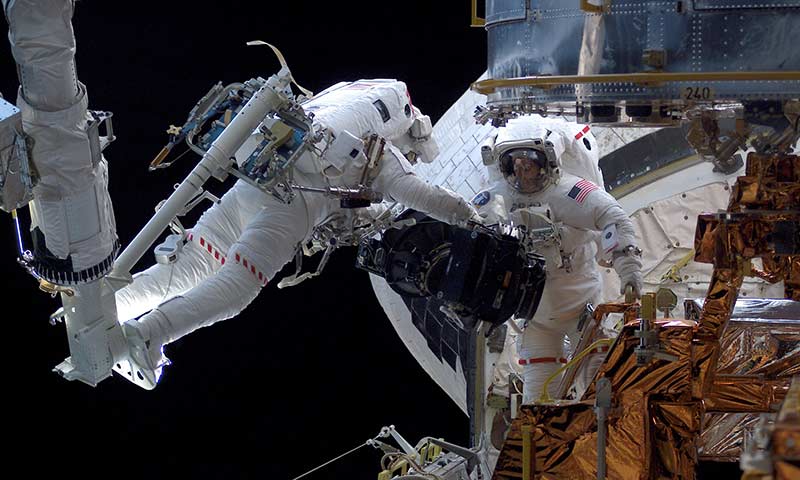
Back in 1957, Carpenter graduated from NPS’ Naval General Line School, a course of instruction in modern naval operations and science for junior Navy officers. With his two young sons, he drove cross-country from NPS to his next assignment in Washington, D.C.; the rest of his family flew ahead. While camping overnight in Nebraska, Carpenter pointed out a bright light in the night sky to his boys and said, “There’s Sputnik!”
Sputnik, the first human-made satellite to orbit Earth, had just been launched by the Soviet Union. And it ignited the “Space Race,” forever changing the domain of space for all nations.
Carpenter, like the others who would be selected for Project Mercury, didn’t know much about becoming an astronaut before Sputnik – because there were no such individuals as astronauts yet. It wasn’t until early 1959 that Carpenter and other military test pilots were summoned for a secret, but volunteer, selection process to become the first Americans in space – the Mercury Seven.
Three years later, flying solo aboard the Mercury-Atlas 7 mission, Carpenter became the fourth U.S. astronaut to reach space, NASA’s second astronaut to achieve orbit, and the very first NPS astronaut. Ever since then, NPS has not taken its finger off the launch button to space.
Not only does NPS count 44 NASA astronauts among its alumni – the most of any graduate school in the U.S. – but another NPS alumnus, retired Navy Cmdr. Brian Binnie, was the first former service member to earn commercial astronaut wings. These trailblazers have flown aboard spacecraft ranging from Mercury, Gemini, Apollo, and Soyuz to the Space Shuttle, SpaceShipOne, and SpaceX’s Crew Dragon; orbited the Earth aboard Skylab and the International Space Station (ISS); and walked on the surface of the moon.
And NPS’ reach into space goes well beyond the flights of astronauts.
The NPS Space Academic Program Emerges
“NPS has this incredible space history that spans decades,” said NPS Associate Research Professor Wenschel Lan, acting chair of the Space Systems Academic Group (SSAG). “And NPS continues to be at the forefront of space engineering and operations. It’s not just science projects. It’s real-world applicability. During every step along the way, we've kept up with industry and kept the focus on defense.”
When students come to NPS from operational duty, they bring with them a wealth of experience and an understanding of capability gaps in technology that can affect readiness. By joining one of the many space research teams at NPS, students use their studies to find solutions that help fill these gaps.
“From a multidisciplinary standpoint, the diversity and richness of the subject matter expertise at NPS is fundamental to the successes of the students and the space program,” Lan said.
The technologies that stem from these successes often transcend space applications and create new technological opportunities across the spectrum of national security interests.
At the start of the 1980s, the Space Systems Academic Committee was formed at NPS because of a strong desire from Washington for NPS to become more formally involved in defense-focused space science and graduate education for military officers. The National Reconnaissance Office and Office of Naval Research sponsored the effort, and both remain enabling agencies to this day. In 1982, the committee turned into the SSAG.
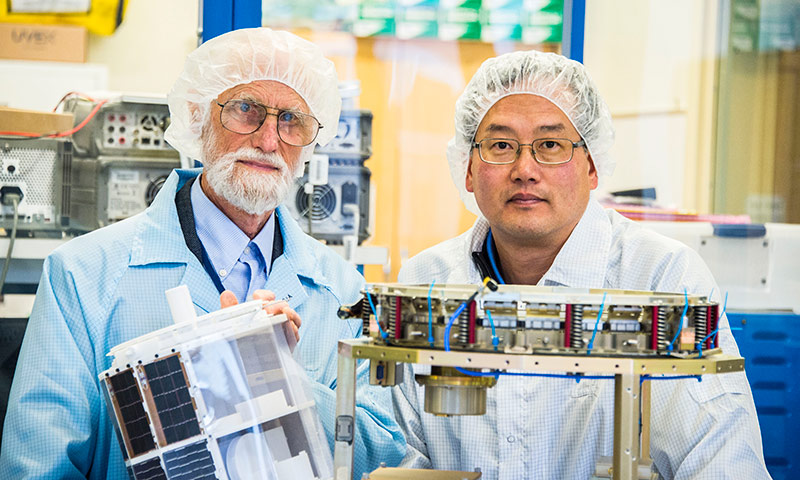
“Right off the bat, I would like to point out the reason why I’ve always tried to keep the Space Systems Academic Group as is, rather than become a department, is that it gives us more flexibility in terms of pulling in people from various departments,” said Professor Emeritus Rudy Panholzer, who started at NPS in 1964 and served as SSAG chair from 1987 to 2016. “Whereas when you are a department, you have a focus of topics within the scope of the department. At the Space Systems Academic Group, you cannot afford to have blinders in terms of the various disciplines. It's multidisciplinary from the start.”
In building the SSAG, there was a strong belief that NPS students needed to get their hands on hardware, build things, make them work, and troubleshoot, if necessary. To accomplish this, SSAG sought to establish very strong space laboratories for the students.
“The curriculum was developed to provide students with the necessary background to build satellites and operate them in support of defense requirements,” said Professor Emeritus Herschel Loomis, who joined the Electrical and Computer Engineering department at NPS in 1981 after an early career developing Navy intelligence satellites and developed coursework for the fledgling SSAG.
The main components of the defense education requirements that SSAG addresses are communications, navigation, reconnaissance, and weather and climate.
“We formed a dual (curricula program) of Space Systems Engineering and Space Systems Operations. It’s a very complimentary relationship having both students in operations and engineering,” said Loomis, discussing how SSAG offers education to best meet defense requirements.
Fast-forward to the present, and one sees just how much the space domain has changed. The Navy and Marine Corps have each established a new designator – Maritime Space Officer (MSO). Filling the ranks of MSOs will build a community of officers with space expertise who will directly support Navy and Marine Corps activities. NPS graduates have become MSOs and newly designated MSOs have started arriving to NPS for their space-focused degree programs.
Additionally, the establishment of the U.S. Space Force and the revival of U.S. Space Command (USSPACECOM) as a unified combatant command have reinforced the importance of joint space operations and education within the DOD. As an acknowledgement of NPS’ role in space systems education, USSPACECOM has accepted NPS into its Academic Engagement Enterprise (AEE), a select partnership of colleges and universities throughout the U.S. that contribute to current and future USSPACECOM domain superiority.
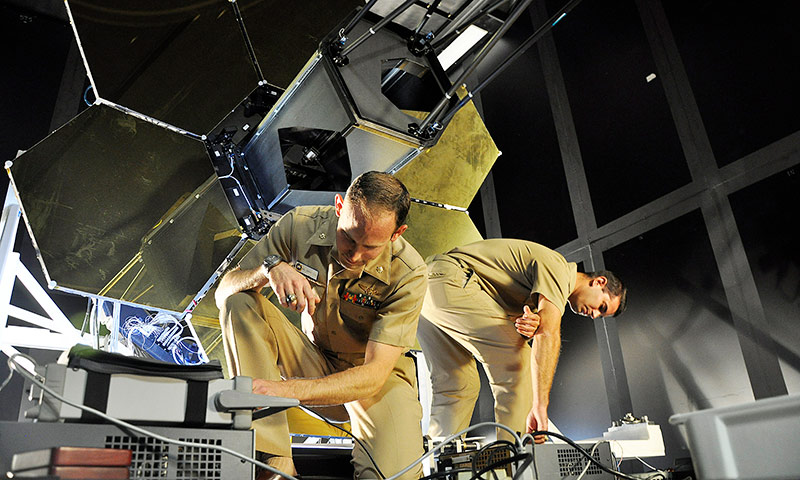
FLTSATCOM and the Segmented Mirror Space Telescope
Due to the rapidly growing need for space expertise in the 1980s, at the height of the Cold War, NPS transformed its Department of Aeronautics into the Department of Aeronautics and Astronautics to complement the SSAG. Students had been using the first book on spacecraft design, Brij Agrawal’s “Design of Geosynchronous Spacecraft” – a textbook that Secretary of the Navy Carlos Del Toro studied while earning his master’s degree in Space Systems Engineering at NPS.
In 1989, the same year that Del Toro graduated, Agrawal was hired by NPS as a professor to lead the Astronautics Program and to develop the Master of Science degree in Astronautical Engineering. Then, in 1991, Agrawal helped NPS’ Spacecraft Research and Design Center acquire a ground test model Fleet Satellite Communications System (FLTSATCOM) Navy communication satellite.
“This was a milestone for NPS,” said Agrawal. “FLTSATCOM is not a museum piece. It's operational. Our laboratory gives students unique access to run experiments and solve problems using a real communication satellite.”
A FLTSATCOM in orbit has a 4.9-meter-diameter antenna dish, 13.2-meter-wide solar array, and a launch mass of roughly 2,000 kilograms. However, since NPS’ FLTSATCOM is used inside a laboratory, it doesn’t have a solar array or thrusters.
Expanding the education and research opportunities for students in 2010, the Spacecraft Research and Design Center added a six-panel, 3-meter-diameter segmented mirror space telescope, which uses adaptive optics to precisely control the shape of its mirror surfaces, much like how the James Webb Space Telescope operates.
This and other space technologies cross over and enable the development of non-space military technologies, such as directed energy applications used well within Earth’s atmosphere.
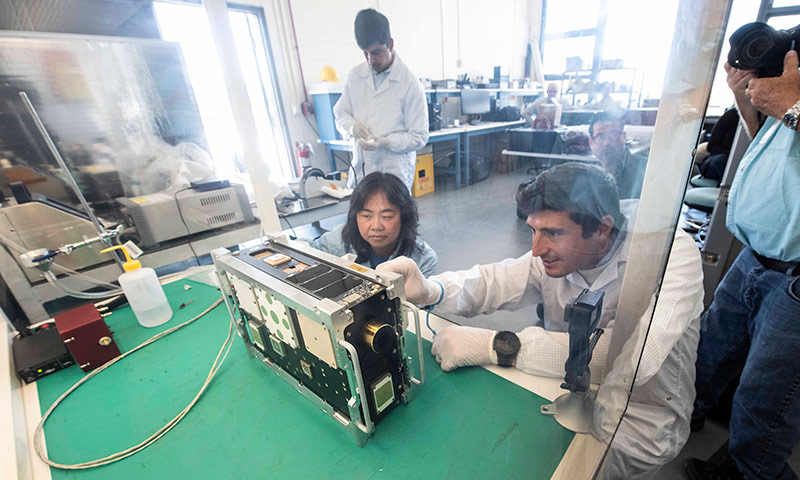
Shifting to Satellites and CubeSats
With a well-established tradition of astronaut alumni, it was now time for NPS to launch its own satellites. In 1998, during STS-95 – the same Space Shuttle mission that featured the return to space of John Glenn, the first American to orbit the Earth – the shuttle Discovery deployed the Petite Amateur Navy Satellite (PANSAT) into low Earth orbit (LEO). As NPS’ first satellite, PANSAT allowed Space Systems Engineering and Space Systems Operations students to develop hardware and communication technology on a 150-pound, low-cost communication small satellite.
Given the cost to develop and launch a satellite, NPS also recognized early the opportunities that standardized, modular nanosatellites known as CubeSats offered for quick and low-cost design, development, and deployment of payloads into orbit. CubeSats are made up of 10 cm x 10 cm x 10 cm cubes called units (U). A CubeSat made from only one cube is represented as 1U. Like building blocks, if made of three cubes, it would be 3U. NPS flew its own CubeSat, NPS-SCAT, in 2013, an experiment to measure solar cell degradation in space.
The next step was the first-of-its-kind NPS CubeSat Launcher (NPSCuL), which was a secondary payload mounted in an empty area of an Atlas V and launched four times, starting in 2012. NPSCuL was not a spacecraft itself, but a spacecraft launcher; the first one contained 13 individual CubeSats and deployed them into their own separate orbits. A total of 46 CubeSats were deployed from NPSCuL between 2012 and 2015. Nowadays, launchers like NPSCuL are commonly used by commercial launch providers.
Among the CubeSats launched by NPSCuL was one of NPS’ first CubeSats, a collaboration with Lawrence Livermore National Laboratory called STARE-A (Space-based Telescopes for Actionable Refinement of Ephemeris). The 3U CubeSat was used to study potential threats from space debris and collisions with other satellites.
In 2019, NPS launched another small satellite aboard a SpaceX Falcon Heavy rocket, the advanced NPS Spacecraft Architecture and Technology Demonstration Satellite (NPSAT1). Designed as a space-based laboratory, the 190-pound NPSAT1 was intended to allow students to run numerous spaceflight experiments to investigate space weather and demonstrate space technology.
Today, NPS continues to develop and launch CubeSats, employing the latest in rapidly developing commercial technology. U.S. Marine Corps Maj. Dillon Pierce, an infantry officer who completed his Space Systems Operations master's degree at NPS in 2019, put his education into practice at Marine Corps Combat Development & Integration (CD&I) to develop emerging space capabilities for the Corps.
Dillon’s success brought him back to NPS, where he is now pursuing a doctorate with a dissertation focused on advanced rocket capabilities, emphasizing cost efficiency and production capacity. This work, sponsored by the Marine Corps Warfighting Laboratory, aims to fill critical operational capability and capacity gaps, with significant anticipated impacts on future military operations.
“What I truly fell in love with was the hands-on aspect of the applied research within the SSAG,” Dillon said. “Coming into the lab and being able to apply theory to real-world capabilities, such as building rockets and CubeSat payloads, is fascinating. It provided me with a deep understanding of the technical concepts learned in the classroom and demonstrated how to apply those concepts to address the operational challenges facing the military today. This practical skill, combined with the technical thinking process of framing and understanding problems, which my dissertation supervisor, Dr. Newman, and my committee excel at, is what I strive to improve upon in my research.”
Most recently, in March 2024, the NPS 6U CubeSat, named Mola, launched into space aboard a Rocket Lab Electron rocket from NASA’s Wallops Island Flight Facility on the Virginia coast with three payloads: Korimako, a radio transmitter built by the New Zealand Defence Science and Technology (DST) group, and two payloads built by NPS – a terahertz imaging camera (TIC) and an LED on-orbit payload (LOOP).
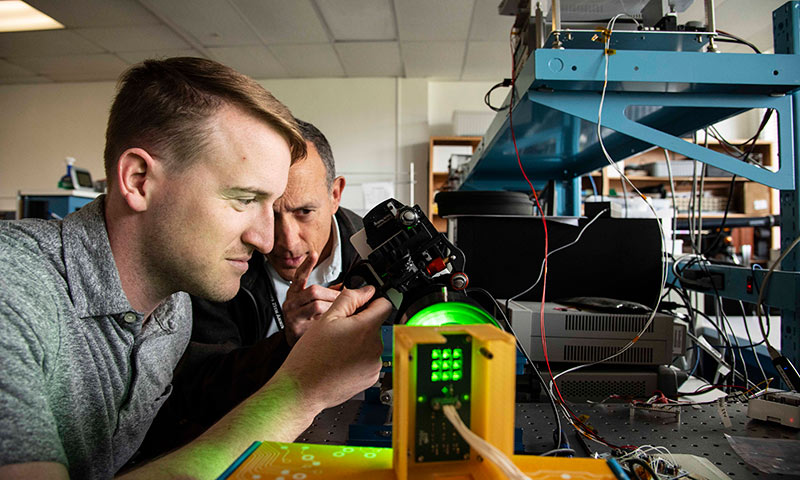
Mola is connected to the Mobile CubeSat Command and Control (MC3) network, a series of ground tracking stations spread across the country that NPS began developing in 2011. The network includes collaborations with academia, industry, and all international partners from the Five Eyes (FVEY) intelligence alliance – Australia, Canada, New Zealand, and the United Kingdom. One of the experiments will use a ground-based optical telescope to observe the green LEDs on LOOP to evaluate how to track objects in LEO. Mola is the first step toward the future goal of high-rate optical communications using the MC3 network.
Scheduled to launch later in 2024, the Otter CubeSat will fly New Zealand DST’s second communications payload, Tui, a risk reduction effort for space-based maritime domain awareness capabilities. Two NPS-built payloads are also manifested on Otter – an X-band transmitter and the next iteration of LOOP to continue experimenting with line-of-sight communications by using two banks of LEDs, transmitting in green and near-infrared wavelengths, that are capable of modulating light for basic messaging. More than 20 NPS students will have directly contributed to the Mola and Otter CubeSats in the FVEY series.
These NPS spacecraft, and others, helped hundreds of students launch their master’s thesis research in Space Systems Engineering and Space Systems Operations. The graduates then apply this hands-on experience directly to DOD missions during the course of their careers.
Robots in Space
“We work with modeling, simulation, and experimental testing of autonomous orbital robotic space systems,” said astrodynamicist Jennifer Hudson, a research associate professor with the NPS Spacecraft Robotics Laboratory. “Many robotic systems, like the arms on the shuttle, are operated by an astronaut at the controls. We've been looking at what you can do with robots operating on their own or with limited human involvement.”
Hudson works with a team that used an experimental set of small, free flying robots called Astrobees that operate inside the ISS and serve as crew assistants. In the zero-G environment, they move around using electric fans but also could use an arm to move between grip holds. In the NPS experiments, the Astrobee robots transported objects and demonstrated robotic hopping using the gripper arm.
Outside of the atmosphere contained by the ISS, propellers don’t work in space. To meet the constraints of motion in a vacuum, the Spacecraft Robotics Laboratory develops robots that move and function like spacecraft themselves.
By experimenting on a large frictionless platform, robotics researchers simulate repair and refueling missions under the conditions of space by testing how robots maneuver around and connect with a satellite that’s also in motion.
Saving Rocket Fuel With Optimal Trajectories
Rocket science isn’t always about designing and building a bigger and better rocket engine. NPS Distinguished Professor Mike Ross and Research Professor Mark Karpenko of the Department of Mechanical and Aerospace Engineering understand that this won’t help a spacecraft that’s already in space. Instead, they’re making the best use of a spacecraft’s limited resources, such as thruster fuel, which cannot be replenished.
Their team investigates the mathematics and physics of how a spacecraft moves in three dimensions by considering the shapes, sizes, and masses of all the parts that make up the spacecraft and additional factors, such as gravity, solar radiation pressure, and other constraints such as obstacle avoidance to keep sensitive instruments away from bright objects.
The team developed fast attitude maneuvering by using numerical algorithms based on Birkhoff’s theorem to determine the most fuel-efficient trajectory for the spacecraft to travel whenever it’s tasked to maneuver into a new orientation. Surprisingly, the optimal path is not necessary a straight line from Point A to Point B, but one that appears circuitous.
Originally tested on the Transition Region and Coronal Explorer (TRACE) solar observatory, fast attitude maneuvering has recently breathed new life into the Lunar Reconnaissance Orbiter (LRO). A version of the idea applied for momentum dumping has also saved millions of dollars in fuel for the ISS and has supported a similar approach to help extend the life of the LRO by several years.
In addition to being able to stretch more missions from LRO, Navy Lt. Cmdr. Timothy Musmanno, a December 2023 Space Systems Engineering graduate, came up with an idea to image Earth and utilizing a maneuver to do it. Using fast attitude maneuvering to efficiently re-task LRO allowed the spacecraft to momentarily shift its gaze from the moon and to take stunning images of Earth.
“We asked NASA, and they said, ‘Yes.’ So, Musmanno designed a maneuver that allowed the spacecraft to be quickly repointed to scan Earth’s surface,” said Karpenko. “We've been able to take ideas from the drawing board and the classroom all the way up to practical and operational implementation on NASA systems. And, obviously, there's all kinds of other applications and implications for DOD space systems.”
Fast attitude maneuvering is applicable across a variety of DOD spacecraft, and other NASA spacecraft, such as the Webb Space Telescope, can also benefit.
The Big Blue Picture and Returning to the Moon
As much as technical innovation drives the successes of the space education program at NPS, there’s also a great need for understanding the big picture of space – something which goes well beyond hardware and software.
“Orbits, particularly LEO, are getting very crowded by the rapidly increasing number of satellites and the growing number of countries and companies entering space,” said Clay Moltz, a member of SSAG and professor in NPS’ Department of National Security Affairs. “How are we going to keep these orbits safe? How can we manage the new commercial traffic, the orbital debris, and the increasing military competition in space?”
As part of their coursework, all Space Systems students get exposure to how history and policy impact the current and future use of space. After graduating from NPS, they will be better prepared with the knowledge and know-how needed to answer questions, like those posed by Moltz, and address the challenges that await on and over the horizon.
“NPS continues to contribute to the Naval space enterprise by working hard to stay relevant in the ever-changing realm of crowded low-earth orbits and contested cislunar space,” said Newman. “Graduates from across NPS conduct thesis and capstone research of immediate and future impact and, even more importantly, are ready to contribute their updated critical thinking skills and space-related knowledge to the benefit of the country’s defense program.”
During the flight of Apollo 17 in December 1972, NPS graduate Gene Cernan became the last human to set foot on the moon. Now, NASA is ramping up the Artemis program for the United States’ return to the lunar surface, with Artemis I orbiting the moon without a crew in 2022.
For Artemis II, scheduled for launch in 2025, NPS alumnus and Navy Capt. Victor Glover will serve as pilot and join three other astronauts on a flyby mission around the moon – the first return to lunar orbit by humans in more than 50 years.
